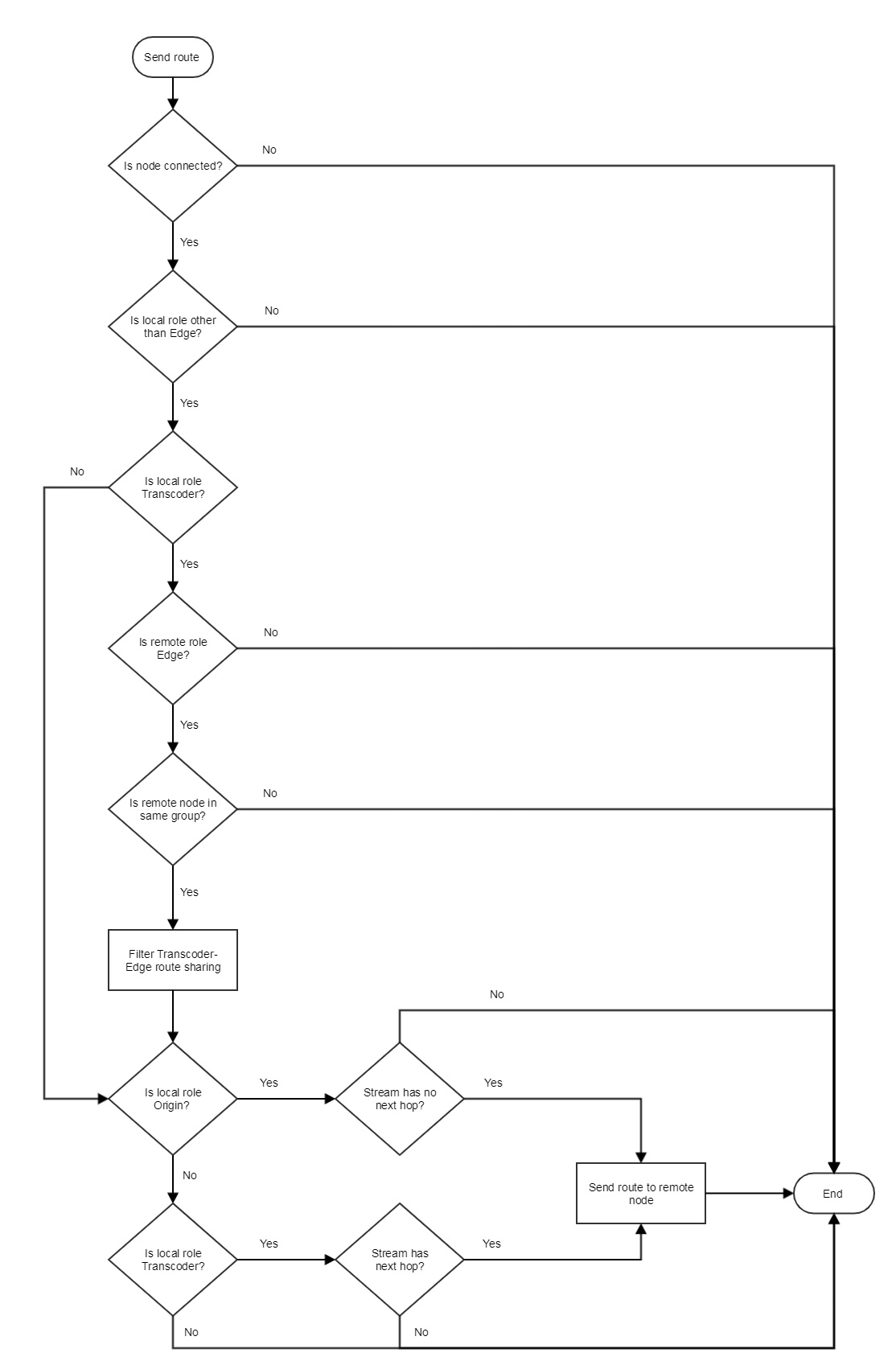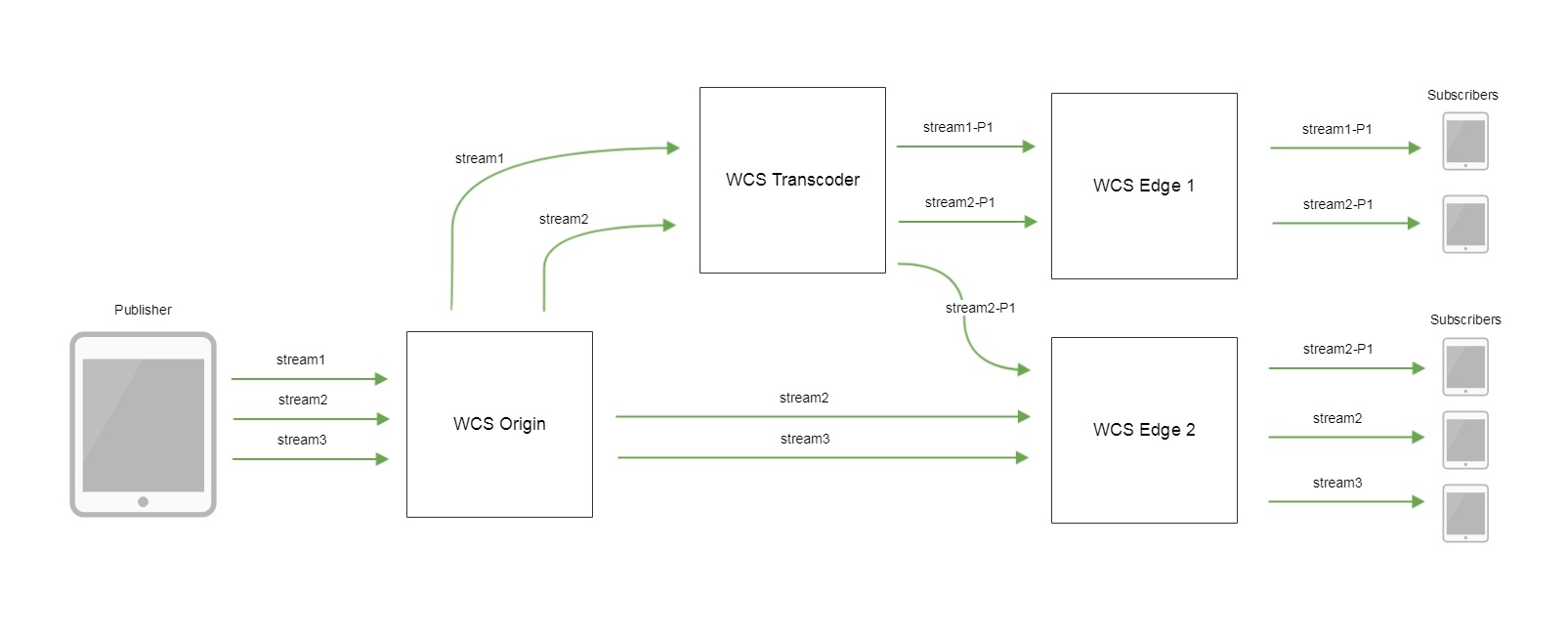| Table of Contents |
|---|
Overview
New CDN 2.1 implementation includes additional features comparing with CDN 2.0:
- CDN nodes grouping by geographical (EU, US etc) or another basis
- CDN nodes can be used for transcoding purposes only by setting Transcoder role to certain nod
CDN nodes grouping
Servers in a CDN can be grouped together by geographical (location), technical (GPU using for transcoding) and anoter basis. CDN group can be assigned to the server with the following parameter in flashphoner.properties file
| Code Block | ||
|---|---|---|
| ||
cdn_groups=group1 |
The same server can belong to several groups. For example, server located in Europe and used for transcoding on GPU:
| Code Block | ||
|---|---|---|
| ||
cdn_groups=EU,GPU |
CDN groups are used to choose a route for stream playback.
All the servers not assigned to any group are considered to belong to the same group.
Transcoder CDN nodes
In order not to load the servers used for publishing and watching videos in a CDN with transcoding tasks, it is advisable to allocate server with increased computing perfomance for these tasks. For such nodes, in addition to Origin and Edge roles, Transcoder role is added.
| Code Block | ||
|---|---|---|
| ||
cdn_role=transcoder |
Transcoder node cannot be used to publish or play streams. This node interacts with Origin and Edge as follows:
1. Stream is published to Origin server
2. Transcoder pulls the stream from Origin server by Edge server request.
3. Transcoder performs stream transcoding by transcoding profile set by Edge server.
4. Edge server pulls the transcoded stream from Transcoder server to play it to subscriber.
The specific node for transcoding is selected when choosing a route for stream playback
Transcoding profiles
To set up transcoding parameters, special profiles are used on Edge server. Transcoding profiles file cdn_profiles.yml should be placed in /usr/local/FlashphonerWebCallServer/conf folder:
| Code Block | ||||
|---|---|---|---|---|
| ||||
profiles:
-webrtc-144:
audio:
type : AudioStreamProfile
codec : opus
rate : 48000
channels : 2
#this part forces transcoding
video:
type : VideoStreamProfile
width : 256
height : 144
codecImpl : OPENH264 |
When stream playback is requested, transcoding profile name shoould be added to stream name to transcode this stream, for example
| Code Block | ||
|---|---|---|
| ||
test-webrtc-144 |
It is recommended to set hyphenated profile names for convinuence.
Profile parameters
...
opus
mpeg4-generic
speex
...
8000
11025
12000
16000
22050
24000
32000
44100
48000
...
1
2
...
FF
OPENH264
...
When stream is transcoded on Edge server
Stream will be transcoded on Edge under the following conditions:
1. If server video codec priority is higher than profile video codec priority. For example, if the following profile is used
| Code Block | ||||
|---|---|---|---|---|
| ||||
-opus-vp8:
audio:
type : AudioStreamProfile
codec : opus
rate : 48000
channels : 2
video:
type : VideoStreamProfile
width : 320
height : 240
gop : 60
fps : 30
codec : vp8
codecImpl : FF |
and the following codec priority is set in server properties
| Code Block | ||
|---|---|---|
| ||
codecs=opus,...,h264,vp8,flv,mpv |
then VP8 stream will be transcoded to H264 because this codec has a higher priority.
2. If there is no audio codec or sample rate from profile in subscribers' SDP, audio track will be transcoded to one of formats supported by subscriber.
Choosing a route for stream playback
CDN routes are based on the following periodic data sendings between CDN nodes:
- Origin sends published streams data to Transcoder and Edge;
- Transcoder sends pulled streams data to Edge in the same group;
- Edge sends nothing and is always an end poit of a route.
| Expand | ||
|---|---|---|
| ||
A route for stream playback on Edge server is chosen as follows:
1. If transcoding profile is set on Edge server:
1.1. If there is the stream with such name on Transcoder node in the same group with Edge:
1.1.1. If the strea, is already transcoded by this profile, Edge pulls the stream from Transcoder
1.1.2. If the stream is transcoded by another profile:
1.1.2.1. Stream will be transcoded by profile set
1.1.2.2. Edge will pull the stream from Transcoder
1.2. If Transcoder that belongs to the same group with Edge can pull the stream with such name from Origin:
1.2.1. Transcoder will pull the stream from Origin
1.2.2. The stream will be transcoded by the profile set.
1.2.3. Edge will pull the stteam from Transcoder
1.3. In other cases, Edge pulls the strea, from Origin
2. If transcoding profile is not set on Edge server, Edge pulls the stream Origin
An example of streams translation via CDN with Transcoder nodes
Where
- stream1, stream2, stream3 – streams published to Origin server
- stream1-P1 – stream1 stream transcoded by settings profile P1
- stream2-P1 – stream1 stream transcoded by settings profile P2
Getting stream routes information with REST API
To get an information about CDN stream routes REST API query /cdn/stream/show_routes is used
REST query should be HTTP/HTTPS POST request as follows:
- HTTP: http://test.flashphoner.com:8081/rest-api/cdn/stream/show_routes
- HTTPS: https://test.flashphoner.com:8444/rest-api/cdn/stream/show_routes
Where:
- test.flashphoner.com - WCS server address
- 8081 - a standard WCS REST / HTTP port
- 8444 - a standard WCS HTTPS port
- rest-api - mandatory part of URL
- /cdn/stream/show_routes - REST query used
REST queries and responses
...
REST query
...
REST query body example
...
REST response example
...
Response states
...
Description
...
/cdn/stream/show_routes
...
| Code Block | ||||
|---|---|---|---|---|
| ||||
{
"streamName":"test-webrtc-144"
} |
...
| Code Block | ||||
|---|---|---|---|---|
| ||||
{
"1-PROFILE-192.168.1.220": [
"AudioStreamProfile{bitrate=0, codec='opus', rate=48000, channels=2}",
"VideoStreamProfile{width=0, height=0, gop=null, fps=null, bitrate=0, codec='H264', codecImpl='null', quality=null}",
"VideoStreamProfile{width=320, height=180, gop=null, fps=null, bitrate=0, codec='H264', codecImpl='FF', quality=null}",
"VideoStreamProfile{width=256, height=144, gop=null, fps=null, bitrate=0, codec='H264', codecImpl='OPENH264', quality=null}"
],
"2-STREAM-192.168.1.220": [
"AudioStreamProfile{bitrate=0, codec='opus', rate=48000, channels=2}",
"VideoStreamProfile{width=0, height=0, gop=null, fps=null, bitrate=0, codec='H264', codecImpl='', quality=null}",
"VideoStreamProfile{width=320, height=180, gop=null, fps=null, bitrate=0, codec='H264', codecImpl='FF', quality=null}",
"VideoStreamProfile{width=256, height=144, gop=null, fps=null, bitrate=0, codec='H264', codecImpl='OPENH264', quality=null}"
],
"3-NEW-TRANSCODER-192.168.1.220": [],
"4-PROXY-192.168.1.219": [
"AudioStreamProfile{bitrate=0, codec='opus', rate=48000, channels=2}",
"VideoStreamProfile{width=0, height=0, gop=null, fps=null, bitrate=0, codec='H264', codecImpl='', quality=null}"
]
} |
...
200 – OK
500 – Internal Server Error
...
Show CDN stream routes
Parameters
...
Description
...
Example
...
Stream name (including transcoding profile if necessary)
...
test-webrtc-144...
1-PROFILE-192.168.1.220...
2-STREAM-192.168.1.220...
AudioStreamProfile{bitrate=0, codec='opus', rate=48000, channels=2}...
VideoStreamProfile{width=320, height=180, gop=null, fps=null, bitrate=0, codec='H264', codecImpl='FF', quality=null}...
3-NEW-TRANSCODER-192.168.1.220...
4-PROXY-192.168.1.219...
AudioStreamProfile{bitrate=0, codec='opus', rate=48000, channels=2}...
| Include Page | ||||
|---|---|---|---|---|
|


